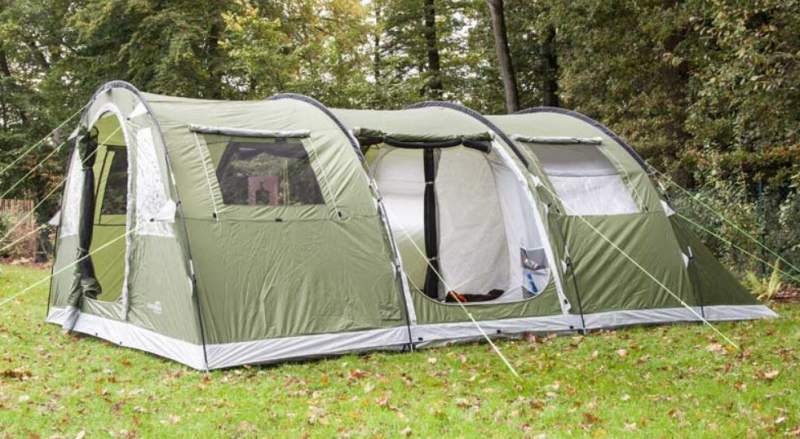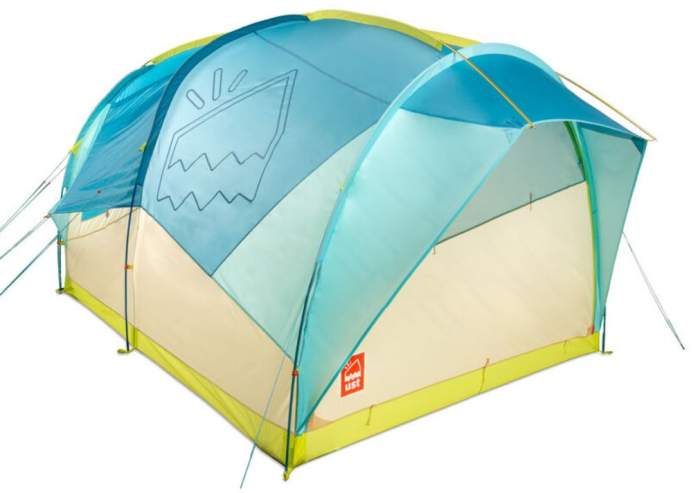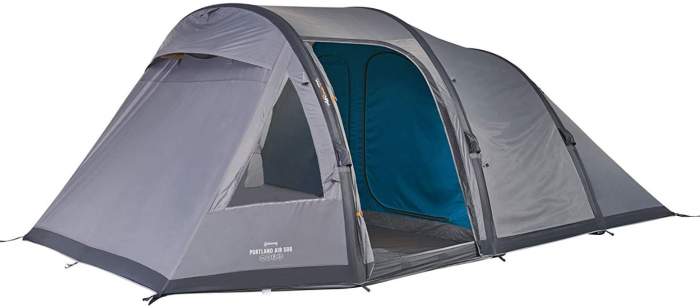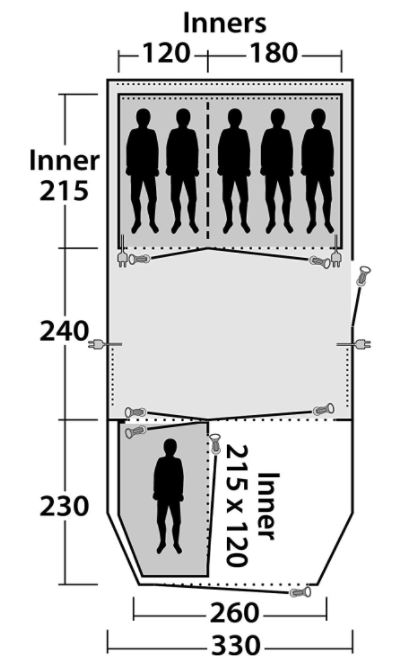Tunnel tents are one out of three most typical tent shapes. So what is a tunnel tent? You will find the answer in the text, keep reading.

A tunnel tent or tunnel-shaped tent is a shelter supported by several loops so that it looks more or less like a half-cylinder. Some tunnel tents may have straight side poles and curved loops only on the roof, so they have steep and straight side walls similar to cabin style tents.
Below I discuss some of the most important features of tunnel tents. This is best done by showing some examples, I have many of them described here in the site and you will see some of them mentioned in the text.
How many layers tunnel tents have?
Most of tunnel tents are hybrid double-single layer type. This means that such tents include a waterproof shell and one or more inner tents that represent sleeping areas. So these sleeping spaces are double-layer areas, and there is usually one living room that is directly under the shell.
But there are also single layer tunnel-shaped tents, the ust House Party Car Camping Tent 6 person is one example:

However, even among tunnel tents you can have true double-layer tents.
Tunnel tents with a sewn-in floor and linked-in floor
The mentioned shell is a waterproof fly that protects the inner space. But the level of protection depends also on the floor design. Quite generally, you can have the following types:
- Fully sewn-in floor. This is the design where the floor is permanently attached to the rest of the tent, and it is completely sealed. If you need a complete protection from crawling insects and from ground water, this is the best option. The Ozark Trail Hazel Creek 18-Person Cabin Tent with 3 Covered Entrances shown in the picture is one example of this type:

Ozark Trail Hazel Creek 18-Person Cabin Tent with 3 Covered Entrances. - Linked-in floor. In this case the floor in the living room is removable, but the inner tent(s) have their own sewn-in and sealed floor(s). In the living room the floor can be attached by toggles or it is just a mat without any attachment. This is good if you have camping furniture like chairs, so you can move the floor to avoid it being damaged by chairs’ feet. The Vango Airbeam Portland Tent 500 is an example of this type:

What kind of support tunnel tents have?
Quite generally you can have 2 types of support:
- Solid poles. This can be fiberglass, steel, or a combination of the two. There are expensive tunnel tents with aluminum poles as well.
- Inflatable beams. Air beams instead of classic poles have been around for more than a decade already. The Vango tent shown above is such an example. A good side of such beams is that they can never break. They may bend under wind pressure but they restore its shape instantly. A bad side is that they cannot withstand pressure from above, so they would collapse under snow.
What kind of fabric is used for tunnel tents?
There are two major groups:
- Synthetic tunnel tents. These are most frequent, and many of them have solid windows.
- Cotton canvas or polycotton tents. These are top quality but heavy and bulky constructions.
Are tunnel tents reliable?
There can be no general statement about reliability of such tents. This depends on many factors, and waterproof rating is one of them. Tunnel tents are very popular on the EU market, and tents which you have there are usually with a huge rating. This is typically in the range of 3000 – 5000 mm HH for the shell, and much more for the floor.
As for their wind resistance, these tents are usually large and tall, so it is best to orient their rear side in the direction of the wind. This is because this side is usually angled and aerodynamic, and it is frequently lower that the rest of the tent.
Reliability is also related to their poles. So steel and aluminum is the best material, but the latter implies a steep price.
How many rooms can tunnel tents have?
This is partly related to the mentioned inner tents. There are tunnel tents with 1, 2, 3, and even 4 inner tents. Some of them can have inner dividers, so a tunnel tent with one inner tent can have 2 sleeping rooms plus a living room, a tunnel tent with two inner tents can have 5 rooms.
These inner tents attach to the shell or to the frame. So you can remove one, or more, or even all the inner tents, and this gives a variety of possible inner rooms.
There are some great tunnel tents that have zippered sections, and those you can attach on two sides of the tent. One great example is the Wildcat Outdoor Gear Lynx 640 Air Inflatable Camping Tent shown in one of the pictures above.
What is capacity of tunnel tents?
You have surely seen many times tents with some official capacity that is totally unrealistic for the actual tent. Well, with tunnel tents it is usually quite the opposite. Namely, the capacity of tunnel tents, in particular those built for the EU market is determined by the number of sleeping pads that can be placed in the inner tent(s).
But living rooms in many of these tents are fully protected and they can easily accommodate several people more. So it is not so rare to see a tunnel tent that can accommodate twice as many people as its official capacity tells you. See the floor plan of this Outwell Woodburg 6A Air Tent. This tent is officially for 6 people, but I am sure it can accommodate 11 or so.

Are there freestanding tunnel tents?
Most of tunnel tents on the market are non-freestanding. This means that they must be staked down properly and you cannot rotate such a tent or move short distances after you put the poles in place and pitch the tent. I would say this is not a big deal in any case because you always have to stake a tent.
But there are indeed tunnel tents that are freestanding. This is because of some clever design where tension in the fabric in combination with one or two ridge poles make the structure self-supporting and freestanding. The REI Kingdom 8 Person Tent shown previously is of this type.
Are tunnel tents ventilated?
The short answer is yes. You have already seen that tunnel tents can have very different structure with respect to layers, and this also determines their ventilation.
So tunnel tents with inner rooms (inner tents) usually have some high vents on the rear side of the shell, and this can be combined with low vents in the living room. In general, this type of tents depends on vents far more than typical cabin style tents.
Many of tunnel tents also have doors with a two-layer configuration, and this means a full size zippered mesh door plus a zippered panel.
What is the best climate for tunnel tents?
Most of tunnel tents currently on the market, and this holds in particular for the tents in the EU, are with solid windows, fully enclosed and with great waterproof rating. So these tents are very suitable for a cooler climate with lots of rain and wind.
Note also that there are some of the best winter tents that are tunnel shaped. But there are tunnel tents that can be used for summer camping as well. For such a climate, make sure that you choose a tent with a mesh door, and if possible with a porch or a large awning.
So this is what I wanted to say about tunnel tents and to have this text as a reference when people ask what a tunnel tent is.
Let me know if you have questions, there is a comment box below. Bookmark this site and come again, this will keep you informed. If you look around you will realize that I add texts here regularly. Thank you for reading.
Thank you for a wealth of knowledge about tunnel tents!
Thank you Tonya, for your kind words, you made my day.